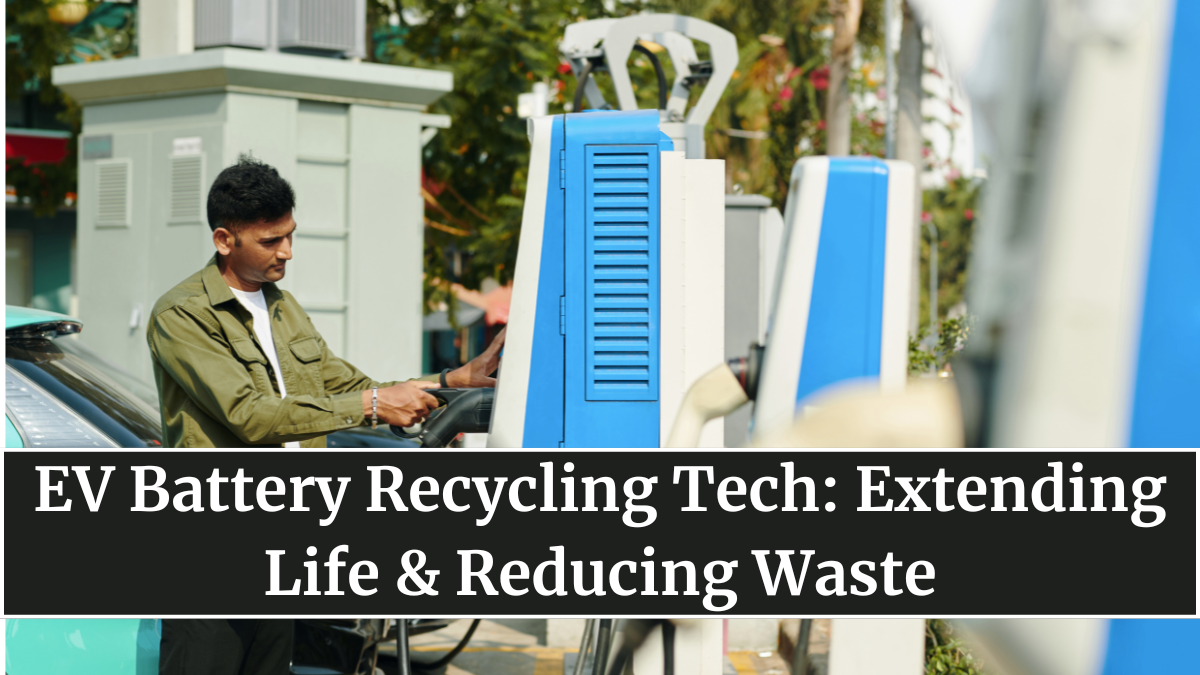Electric vehicles have transformed mobility, but their batteries are now becoming the next environmental challenge. The rise of electric vehicle battery recycling tech is ensuring that the EV revolution remains truly sustainable. With millions of lithium-ion batteries expected to retire in the coming decade, new technologies are stepping up to extend their life, recover valuable materials, and reduce the strain on natural resources.
What was once seen as a disposal problem has become one of the most exciting innovations in clean technology — where recycling meets resource recovery and renewable energy.

The Growing Challenge of Battery Waste
As global EV adoption soars, the world is projected to face over 11 million tons of used EV batteries by 2030. These batteries still contain valuable materials like lithium, nickel, cobalt, and manganese, but without proper recycling, they can contribute to massive environmental waste.
The challenge lies in safely dismantling and extracting these components while minimizing emissions and energy use. Traditional recycling methods often involved high-temperature smelting, which was energy-intensive and polluting. But the new generation of closed-loop recycling technologies is changing that.
How Modern EV Battery Recycling Works
Recycling an EV battery is a multi-step process combining chemistry, robotics, and advanced AI systems. Modern facilities use several techniques to maximize recovery:
-
Mechanical separation: Breaking down the battery pack into modules and cells for safe material extraction.
-
Hydrometallurgical recycling: Using chemical leaching to recover lithium, cobalt, and nickel with higher purity and lower energy use.
-
Direct cathode recycling: Preserving battery materials to reuse directly in new cells, reducing waste drastically.
-
Automation and robotics: Disassembling battery modules safely to minimize worker exposure and improve efficiency.
These processes can now recover up to 95% of critical materials, making battery recycling not just sustainable but economically viable.
Leading Innovators in EV Battery Recycling
A new wave of companies and research partnerships is pushing the boundaries of recycling efficiency.
| Company | Country | Innovation Focus |
|---|---|---|
| Redwood Materials | USA | Closed-loop lithium and nickel recovery for EV makers |
| Li-Cycle | Canada | Hydrometallurgical “spoke & hub” recycling system |
| Attero Recycling | India | Large-scale e-waste and EV battery recovery network |
| Ascend Elements | USA | Cathode-to-cathode recycling for new battery production |
| Umicore | Belgium | Industrial-scale battery material refining for global OEMs |
Automakers are also entering the recycling game. Tesla, Hyundai, and Tata Motors have started partnering with recyclers to reuse recovered metals in their next-generation EVs, reducing dependence on imports and raw mining.
The Rise of Second-Life Battery Applications
Before reaching recycling plants, many EV batteries are now being given a “second life.” Even after their vehicle use ends, most batteries retain around 70–80% of their capacity, which can be repurposed for less demanding applications.
These second-life uses include:
-
Energy storage for solar and wind farms
-
Backup power for data centers and telecom towers
-
Residential energy systems for off-grid homes
-
Charging station energy buffers for peak-demand hours
This not only extends the lifecycle of each battery but also reduces the total environmental footprint of EV manufacturing.
Environmental and Economic Impact
Battery recycling could reduce the need for mining by up to 40%, cutting emissions and preserving ecosystems affected by lithium and cobalt extraction. Economically, it’s a trillion-dollar opportunity — the global battery recycling market is projected to surpass $35 billion by 2030.
Governments are introducing stricter regulations requiring manufacturers to take responsibility for the end-of-life management of their batteries. India, the European Union, and the United States are all developing Extended Producer Responsibility (EPR) frameworks to ensure circular battery lifecycles.
The Future of Closed-Loop Battery Systems
The ultimate goal of recycling technology is a fully closed-loop system, where materials from old batteries directly power new ones — infinitely recyclable, infinitely efficient.
AI and machine learning are now being integrated to analyze battery degradation, predict recovery efficiency, and optimize the reprocessing pipeline. New breakthroughs, such as solid-state batteries, are being designed with recyclability in mind from the start.
By 2035, every major EV manufacturer is expected to have an in-house recycling or second-life division — marking the era of circular energy mobility, where nothing truly goes to waste.
FAQs
Why is EV battery recycling important?
It prevents toxic waste, conserves resources like lithium and cobalt, and supports a circular economy for sustainable EV production.
How much of an EV battery can be recycled?
Modern recycling processes can recover up to 95% of materials like nickel, cobalt, lithium, and copper.
What happens to old EV batteries after use?
They’re either repurposed for energy storage (second life) or sent to recycling facilities to extract valuable raw materials.
Which companies are leading in battery recycling?
Redwood Materials, Li-Cycle, Attero Recycling, and Ascend Elements are global leaders in EV battery recycling innovation.
What’s the future of EV battery recycling?
The future lies in closed-loop systems, where recycled materials continuously feed new battery production, reducing the need for new mining.
Click here to know more.
